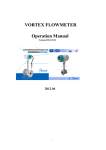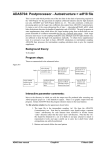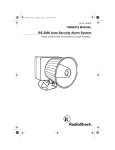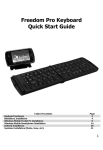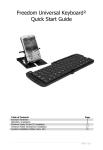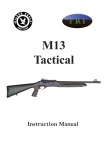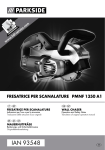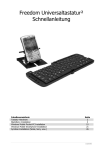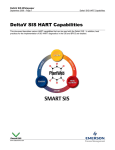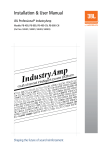Download User Manual
Transcript
ELECTRONIC DISPLAYS INC. 135 S. CHURCH STREET ADDISON, ILL. 60101 www.electronicdisplays.com NUMERIC PRODUCTS MANUAL Thank you for purchasing and Electronic Displays Inc. numeric model. If for any reason you need technical support please visit our support site http://edisupport.helpserve.com/. Electronic Displays, Inc. Thank you for purchasing this high-quality EDI product. We value your business. This document covers what you need to know to install and use the display. If, after a careful reading, If you feel you need assistance after consulting this manual, please contact our technical staff at http://edisupport.helpserve.com If you would like a full catalog of our counters, timers, message marquees, industrial scoreboards, or any of our other products, please contact EDI customer service. Made Proudly in the USA Unpacking Open the box carefully to avoid cutting or scratching the unit. Mounting These displays are available in a variety of enclosures, or without any enclosure. NEMA 1 and NEMA 12 enclosures There are two ¼–20 Rivnuts on the top of the unit, with 1¾" bolts already installed. To avoid damaging the Rivnuts, don’t tighten the bolts beyond 20 foot-pounds. We do not recommend drilling other mounting holes. You are likely to damage the circuit board. NEMA 4 and NEMA 4X enclosures The display is designed to hang from a ceiling or mount to a wall using the two 5/16" holes at the top of the brackets. panel mount These models are bolted to an oversized plastic filter. You can drill holes in the filter to fit your mounting needs. The standard filter is acrylic (Plexiglas). A Lexan™ filter is optional. 2 Copyright © 2004 Electronic Displays, Inc. Power Supply The display operates on 60Hz, 120V AC. (Models operating at 12V and 24V AC, 12V DC, and 50Hz, 220V are available.) It is equipped with an 18-gauge, three-wire cord, which should be connected to a properly grounded receptacle. Do not try to defeat the grounding. Warning — Shock Hazard Line voltage (120V AC) is present inside the unit. Completely disconnect power before opening. Do not operate the unit unless the covers are in place and screwed down. Service This display has no user-serviceable parts. The cover can be cleaned using a mild glass-cleaning solution and a soft cloth. Warranty Our standard warranty is one year, parts and labor, when the product is returned shipping charges-prepaid to Electronic Displays for repair. Please contact our service department before returning the unit, so we can confirm whether service is required. Electronic Displays repair department Unit A 135 South Church Street Addison, IL 60101 (630) 458-9611 [voice] (630) 628-0936 [FAX] http://edisupport.helpserve.com 2 Seven-Segment Displays 3 Options Options can be ordered to customize a display for specific needs. Options are indicated by suffixes to the basic model number. The following options are “standard” — they are available on all models. OPTION 12AC DESCRIPTION The display is powered by a user-supplied source of 10V to 12V AC. 6D The display is six-digit. (Standard is four.) DF Two displays are mounted back-to-back. GR The display uses indoor green LEDS. (Standard is red.) HZ The display operates on 220V 50Hz. (Standard is 120V 60Hz.) LX The display face filter is Lexan™. (Standard is acrylic.) N12 The display is mounted in a NEMA 12 rated extrusion. N4 The display is mounted in a NEMA 4 rated cabinet. N4X The display is mounted in a NEMA 4 rated stainless-steel cabinet. PM The display is mounted to the face filter. There is no cabinet. PMNF YL The display has neither a face filter nor a cabinet. The display uses indoor yellow LEDS. (Standard is red.) Some options are “specific” — they are available, or not available, on specific models. The following options are available only on the listed models. OPTION DESCRIPTION available models AO The display includes an audible output that sounds for three seconds when a set point is reached. 103, 104, 105, 110 DP1 The display can include a floating decimal point. Its position is set when the user recalibrates the display. 111, 117 3 4 Copyright © 2004 Electronic Displays, Inc. A 16-key keypad is mounted on the rear of the cabinet. This option not available on cabinetless models. 103, 104, 105, 110, 111, 115, 117 KYN1 A 16-key keypad is mounted on a NEMA 1 rated box and connected to the display, either hard-wired or with with a 10' cable and a 25-pin sub-D connector. 103, 104, 105, 110, 111, 115, 117 KYN12 A 16-key keypad is mounted on a NEMA 12 rated box and connected to the display with a 10' cable and a 25-pin sub-D connector. 103, 104, 105, 110, 111, 115, 117 KY NAD A SPST push-button switch is mounted on the end plate, to be wired as the user desires. 102, 103, 104, 109 RC1 A NEMA 1 rated remote-control box is provided with push-button switches and/or thumb-wheel switches, hard-wired to the display. 102, 103, 104, 109 RC2 A NEMA 12 rated remote-control box is provided with push-button switches and/or thumb-wheel switches, hard-wired to the display. 102, 103, 104, 109 RL A relay mounted in the display closes at setpoint. 103, 104, 110 XF1 A 120V to 12V AC step-down transformer is supplied for the Run / Hold or Count input. 102, 103, 104, 109, 110, 115 XF2 A 120V to 12V AC step-down transformer is supplied for the Reset or Preset input. 102, 103, 104, 109, 110 XF3 Two 120V to 12V AC step-down transformers are supplied for the Run / Hold or Count input and Reset or Preset input. 102, 103, 104, 109, 110 P1 4 The display has a “non-addressable” protocol, which 111, 117 is identical to the standard protocol except for deletion of the two-digit address. Seven-Segment Displays 5 The following options are available on all models except those listed. OPTION DESCRIPTION excluded models 12DC The display is powered by a customer-supplied source of 10V to 12V DC. This option is not available on models that use the AC line frequency as a timebase, or do not have an internal timebase. 101 24DC The display is powered by a customer-supplied source of 24V to 28V DC. This option is not available on models that use the AC line frequency as a timebase, or do not have an internal timebase. 101 5D The display has five digits. This option is not available for clock displays. 101, 102, 103, 104, 106, 113 7D The display has seven digits. Not available for clock displays. 101, 102, 103, 104, 106, 113 8D The display has eight digits. Not available for clock displays. 101, 102, 103, 104, 106, 113 BT Display values and user-alterable parameters are retained in battery-backed memory and restored after power loss. 105, 112, 114 DP2 A fixed decimal point is displayed at a position specified when the display is ordered. Not available for clock displays. 102, 103, 104, 106, 113 SD1 A 25-pin female sub-D connector is mounted on the end of the display for the detachable keypad. 102, 109, 111, 112, 114, 117 SD2 A 9-pin femae sub-D connector is mounted on the end of the display for the detachable keypad. 102, 109, 111, 112, 114, 117 SR1 The serial data interface is RS-232. 105, 112, 114 SR2 The serial data interface is RS-422/485. 105, 112, 114 5 6 Copyright © 2004 Electronic Displays, Inc. Clocks General Information Clocks use the line frequency for their timebase. The 50/60 Hz setting is internal and hard-wired. It cannot be changed. An optional internal timebase is available for DC operation. model 101 stand-alone clock / primary time display The 101 is a primary clock. It can control the 113 secondary display using the TX+ and TX– connections on the internal terminal strip. The four-digit models display time in HH:MM format. The six-digit model displays time in HH:MM:SS format. The default display is 12 hours. (There is no AM/PM indication.) To switch the display to 24-hour, remove the plug from the back panel. Using chain-nose or needle-nose pliars, remove the wire jumper on the 8-pin DIP socket. When the display is plugged in, the clock reads the time from an internal batteryoperated clock chip and sets the display. Whenever the display is updated or reset, the internal clock chip is set to the same time. The clock battery is a primary lithium cell soldered to the PC board. It should last several years under normal use. The display should be returned to Electronic Displays for battery replacement. Two momentary push-button switches on the right side set Hours and Minutes. Holding down either switch advances the setting rapidly. Seconds are set to “zero” at the moment you release the Minutes switch. User-supplied switches can be wired to the internal terminal strip for remote setting. 6 Seven-Segment Displays 7 model 113 secondary display for Perfect Time system and Masterless Master-Time system The 113 models are four- or six-digit secondary displays controlled by the 101 primary display over an RS-422/485 interface. A multi-drop daisy-chain RS-422/485 interface permits up to 30 displays to be controlled by a single primary clock. The maximum length of the cabling (which must be suitable for an RS-422/485 connection) is 1000'. If there is no data input when the unit is plugged in, it reads the time from an internal battery-operated clock chip and sets the display. The clock chip is updated when the primary display sends the correct time. The clock battery is a primary lithium cell soldered to the PC board. It should last several years under normal use. The display should be returned to Electronic Displays for battery replacement. The display is updated once per second. If five seconds pass without data input, the unit adds five seconds to the internal clock chip’s time and starts counting on its own, using the clock chip’s timebase. There is no visual indication that the data signal has been lost. Timers General Information Timers use the line frequency for their timebase. The 50/60 Hz setting is hard-wired. It cannot be changed. An optional internal clock is available, permitting DC operation. When timers are first turned on, they execute a self-test that displays all ten digits in all four positions. They then display – – – X, where X is a digit indicating the baud rate for devices having a serial interface doesn’t show it. For timers with a serial interface, the default rate is 1200 baud. 7 8 Copyright © 2004 Electronic Displays, Inc. model 102 up-timer with run / hold / reset The four-digit displays count minutes and seconds (MM:SS) or hours and minutes (HH:MM). The six-digit display counts hours, minutes, and seconds (HH:MM:SS). The four-digit displays count up to 99:59, then roll over to zero and continue to count. The six-digit display counts up to 99:59:59, then rolls over to zero and continues to count. User-supplied momentary-contact switches must be connected to the internal terminal strip for Run / Hold and Reset. Counting begins (or continues) when the input 1 switch is closed. (It can remain closed, but doesn’t have to.) The timer pauses (holds) when the switch is briefly closed a second time. Closing the input 2 switch resets the counter to zero. The switches can be powered by the Vext supplied by the unit (dry contact), or external DC of 5 to 24 volts (wet contact), as shown below. model 103 down-timer with preset, run / hold The four-digit displays count minutes and seconds (MM:SS) or hours and minutes (HH:MM). The six-digit display counts hours, minutes, and seconds (HH:MM:SS). When counting down, all the timers stop at zero minutes and zero seconds. During a down-count, if the preset number of seconds is greater than 61, the timer immediately jumps to 59 seconds when it starts to run. The preset time is selected using the four thumbwheel switches on the right side. On the six-digit model, the seconds preset is fixed at 00. When plugged in, the display is automatically set to the switch values. The Preset switch resets the display to the current switch values, even if the timer is running, and 8 Seven-Segment Displays 9 the timer continues to run. As shipped, the Preset switch is installed and wired to the internal terminal strip using the dry connections. Run / Hold requires a user-supplied locking or toggle switch. The timer runs when this switch is closed, and holds (pauses) when the switch is open. The switches can be powered by the Vext supplied by the unit (dry contact), or external DC of 5 to 24 volts (wet contact), as shown below. model 104 up / down timer with preset, direction, run / hold The four-digit displays count minutes and seconds (MM:SS) or hours and minutes (HH:MM). The six-digit displays counts hours, minutes, and seconds (HH:MM:SS). The four-digit displays count up to 99:59, then roll over to 00:00 and continue to count. The six-digit display counts up to 99:59:59, then rolls over to 00:00:00 and continues to count. When counting down, all the timers stop at zero minutes and zero seconds. During a down-count, if the preset number of seconds is greater than 61, the timer immediately jumps to 59 seconds when it starts running. The preset time is selected using the four thumbwheel switches on the right side. On the six-digit model, the seconds preset is fixed at 00. When plugged in, the display is automatically set to the switch values. The Preset switch resets the display to the current switch values, even if the timer is running, and the timer continues to run. The Direction switch reverses the timer’s current direction, and the timer continues to run. When plugged in, the timer’s default direction is up. As shipped, the Direction and Preset switches are installed and wired to the internal terminal strip using the dry connections. Run / Hold requires a user-supplied locking or toggle switch. The timer runs when this switch is closed, and holds (pauses) when the 9 10 Copyright © 2004 Electronic Displays, Inc. switch is open. The switches can be powered by the Vext supplied by the unit (dry contact), or external DC of 5 to 24 volts (wet contact), as shown below. 10 Seven-Segment Displays 11 Counters General Information When counters are first turned on, they execute a self-test that displays all ten digits in all four positions. They then display – – – X, where X is a digit indicating the baud rate. For counters with a serial interface, the default rate is 1200 baud. model 109 up counter with reset When plugged in, the counter displays 0000. When the count reaches 9999, it rolls over to 0000 and continues. Counting requires a user-supplied momentary-action switch connected to input 1 on the internal terminal strip. The counter increments when this switch is closed, then opened. Holding it closed does not produce a continuous increment. A user-supplied momentary-action switch connected to input 2 on the internal terminal strip resets the counter. The counter resets when the switch is closed. The switches can be powered by the Vext supplied by the unit (dry contact), or external DC of 5 to 24 volts (wet contact), as shown below. 11 12 Copyright © 2004 Electronic Displays, Inc. model 110 up/down counter with preset, direction, count The preset is selected using the four thumbwheel switches on the right side. When plugged in, the display is automatically set to the switch settings. The Preset switch resets the display to the current switch settings. The Direction switch reverses the counter’s current direction. When plugged in, the timer’s default direction is up (increment). When counting down, the counter stops at 0000. When counting up, the counter stops at 9999 without rolling over. As shipped, the Direction and Preset switches are installed and wired to the internal terminal strip using the dry connections. Direction is input 2 and Preset is input 3 (not shown). Count (input 1) requires a user-supplied momentary-action switch. The counter increments / decrements each time this switch is closed, then opened. The switches can be powered by the Vext supplied by the unit (dry contact), or external DC of 5 to 24 volts (wet contact), as shown below. 12 Seven-Segment Displays 13 Data Displays models 111 & 117 data displays The 111 and 117 are multi-digit data displays. They are identical, except for the interface. The 111 has an RS-232 interface, the 117 an RS-422/485, as shown below. The data input connects to the Sig+ and Sig– inputs. RS-232 transmission should be at 1200 baud, 8 data bits, 1 stop bit, no parity. We do not recommend paralleling multiple 111 units, as the RS-232 standard is not designed for such operation. A multi-drop daisy-chain RS-422/485 interface permits up to 30 117 displays to be controlled by a single device (terminal or computer). The maximum length of the cabling (which must be suitable for an RS-422/485 connection) is 1000'. When the unit is plugged in, the display cycles through all the digits in each position (0000, 1111, 2222, and so on), to confirm the LEDs are working. It then cycles through a sequence that shows the address (Axx), the baud rate (bx), the display length (Uxx), and the display protocol (–n). The sequence is repeated indefinitely until a data stream appears at the input (RS-232 or RS-422/485). The data stream comprises a start character, an address, the data, and a stop character. There are no spaces in the data stream, unless they are part of the data. • The start character is CTRL+B. (Press and hold the CTRL key, then press B.) • The address is the address of the unit that is to display. It is two ASCII digits. The leading zero is required for addresses between 00 and 09. When the address is 00, every unit displays the data. • The data are as many ASCII digits as required to fill the display, plus a decimal point (if needed). If there’s a minus sign (–) for negative values, the number of digits that can be displayed is reduced by one. A space can replace any of the digits. • The stop character is CTRL+C. (Press and hold the CTRL key, then press C.) To display the values –3.14 and 2.78, separated by two spaces, on a ten-digit display with an address of 15, you would transmit the following sequence of fifteen ASCII 13 14 Copyright © 2004 Electronic Displays, Inc. characters, either from a terminal or a computer program. CTRL+B 15 – 3 . 1 4 SPACE SPACE 2 . 7 8 CTRL+C The data is displayed on all units having the given address (15 in this example). 00 is the broadcast address — the data is displayed on all units, regardless of their settings. The default baud rate is 1200. The default address is 01. When more than one display is purchased at the same time, their addresses are set in sequence, starting from 01. To change the baud rate or address, remove the plastic plug on the back of the display and set the DIP switch as shown in the following tables. Changes do not take effect until the unit is turned off, then on again. BAUD RATE POWER-UP DISPLAY switch 7 switch 8 1200 b3 OFF OFF 2400 b4 ON OFF 4800 b5 OFF ON 9600 b6 ON ON DIP switches 1 through 6 can be set for a total of 64 addresses, 1 through 64. If you think of switch 1 as the least-significant bit (LSB), and switch 6 as the most-signficant bit (MSB), simply set the binary value of the address, as shown in the table examples. IMPORTANT Setting the switches to 000000 (all OFF) sets the address to 64, not 00. ADDRESS switch 6 switch 5 switch 4 switch 3 switch 2 switch 1 01 OFF OFF OFF OFF OFF ON 02 OFF OFF OFF OFF ON OFF 03 OFF OFF OFF OFF ON ON 04 OFF OFF OFF ON OFF OFF 05 OFF OFF OFF ON OFF ON … … … … … … … 60 ON ON ON ON OFF OFF 14 Seven-Segment Displays 15 61 ON ON ON ON OFF ON 62 ON ON ON ON ON OFF 63 ON ON ON ON ON ON 64 OFF OFF OFF OFF OFF OFF There is a second “function” DIP switch that controls the display protocol. switch 1 switch 2 switch 3 POWER-UP DISPLAY PROTOCOL OFF OFF OFF –0 non-addressable; LZB off ON OFF OFF –1 non-addressable; LZB on OFF ON OFF –2 2-digit addressable flexible; LZB off ON ON OFF –3 2-digit addressable flexible; LZB on OFF OFF ON –4 2-digit addressable decimal locator; LZB off ON OFF ON –5 2-digit addressable decimal locator; LZB on • Non-addressable means the data is displayed, whether or not the address in the data stream matches the switch setting. Addressable means the the data is displayed only if the address in the data stream matches the switch setting, or is 00. • When LZB is on, leading zeros are blanked (displayed as spaces). • Flexible means the displayed value can include a decimal point, a minus sign, and spaces. • Decimal locator means that the decimal point is not included in the data. Its position is indicated by the last digit in the number, which is not displayed. For example, if the last digit is 3, the decimal point is positioned to the right of the third digit. 15 16 Copyright © 2004 Electronic Displays, Inc. Switches 4 and 5 are reserved for future use and should be left in the off position. Switches 6, 7, and 8 specify the length of the display. switch 6 switch 7 switch 8 POWER-UP DISPLAY DISPLAY SIZE OFF OFF OFF U02 1 or 2 digits ON OFF OFF U04 3 or 4 digits OFF ON OFF U06 5 or 6 digits ON ON OFF U08 7 or 8 digits OFF OFF ON U10 9 or 10 digits ON OFF ON U12 11 or 12 digits OFF ON ON U14 13 or 14 digits ON ON ON U16 15 or 16 digits 16 PROTOCOL FOR REMOTE KEYPAD (NUMERIC DISPLAYS) The sequence of keys to enter values on the top four lines of the scoreboard is as follows: 1. Press the key marked with an A(upper right hand corner ‘A’). 2. Press the two numeric keys representing the desired address of the display 3. Press the one to four numeric keys that represent the value to be displayed 4. Press the key labeled ‘D’ (lower right hand corner) Examples: To display ‘1234’ on the display addressed as ‘01’, the key sequence is as follows: ‘A’ “01” “1234” ‘D’ To display ‘987’ on the display addressed as ‘01’, the key sequence is as follows: ‘A’ “01” “987” ‘D’ BAUD RATE @ 1200BPS ; NO PARITY ; 8 DATA BITS ; 1 STOP BIT PROTOCOL FOR REMOTE KEYPAD – NO ADDRESSING The sequence of keys to enter values on the top four lines of the scoreboard is as follows: 1. Press the key marked with an A(upper right hand corner - ‘A’). 2. Press the one to four numeric keys that represent the value to be displayed 3. Press the key labeled ‘D’ (lower right hand corner) Examples: To display ‘1234’ on the display, the key sequence is as follows: ‘A’ “1234” ‘D’ To display ‘987’ on the display, the key sequence is as follows: ‘A’ “987” ‘D’ Questions?? Visit www.electronicdisplays.com E-mail: [email protected] Seven-Segment Displays 17 model 105 analog-to-digital converter with display The 105 models convert an analog input (either voltage or current) into a four-digit display, linearly proportional to the input. The 105 is factory-configured to read current or voltage, over a specified range listed in the table below. When the input is less than or equal to the lower input value, the display reads 0000. When the input is equal to or greater than the upper input value, the display reads 2000. CURRENT INPUT CODE VOLTAGE INPUT CODE 0 – 1 mA DC C1 0 – 1 V DC V1 0 – 10 mA DC C2 0 – 2 V DC V2 0 – 100 mA DC C3 0 – 5 V DC V3 1 – 5 mA DC C4 0 – 10 V DC V4 4 – 20 mA DC C5 0 – 100 V DC V5 10 – 50 mA DC C6 0 – 200 V DC V6 -1 – +1 mA DC C7 0 – 500 mV DC V7 -10 – +10 mA DC C8 1 – 5 V DC V8 The last three sections of the model number indicate the input type and range, and the factory calibration. For example, an ED400-105-4D-N1-C5-0-2000 has a currentsensing input (C5). At 4mA, the display reads 0000. At 20mA, the display reads 2000. Calibration The display can easily be recalibrated. You need an adjustable current or voltage source, plus a computer, terminal, or keypad with an RS-232 serial output. (Most computer operating systems include a terminal program, such as HyperTerminal.) The input connects to Sig+ and Sig– on the terminal block.. Data input is through the third terminal on the block, or pin 3 on the optional DB-25. Ground is through the fourth terminal or pin 7 on the DB-25. On a PC-type computer, the data connection is to pin 3 (DB-15 COM port) or pin 2 (DB-25 COM port). The 17 18 Copyright © 2004 Electronic Displays, Inc. grounds are pins 5 and 7, respectively. Please refer to the manual for your keyboard or manual for its serial pinouts. No other connections are required. Transmission should be at 1200 baud, 8 data bits, 1 stop bit, no parity. No special settings or preparation are required. Simply hook the computer or terminal to the display with the appropriate RS-232 cable. The basic calibration procedure is to apply the miminum or maximum input to the display, then tell it (through the serial input) what value you want displayed. To calibrate for the minimum display… 1. Apply the minimum input to the display. (If this is zero volts or milliamps, you can simply short the input.) 2. On the keyboard or terminal, press CTRL+B. 3. Press 0 (zero). 4. Press the four digits you want displayed for the minimum input, such as 0010. If you want a negative display, prefix the digits with a dash (-). If you have the floating-point option, add a decimal point (.) at the desired position. 5. Press CTRL+C. To calibrate for the maximum display… 1. Apply the maximum input to the display. 2. On the keyboard or terminal, press CTRL+B. 3. Press 7 (seven). 4. Press the four digits you want displayed for the maximum input, such as 2999. If you want a negative display, prefix the digits with a dash (-). If you have the floating-point option, add a decimal point (.) at the desired position. 5. Press CTRL+C. You can change either setting without having to change the other. If you make a mistake, simply start over again with CTRL+B. 18 Seven-Segment Displays 19 Baud Rate switch 7 switch 8 1200 OFF OFF 2400 ON OFF 4800 OFF ON 9600 ON ON ADDRESS switch 1 switch 2 switch 3 switch 4 switch 5 switch 6 64 OFF OFF OFF OFF OFF OFF 01 ON OFF OFF OFF OFF OFF 02 OFF ON OFF OFF OFF OFF 03 ON ON OFF OFF OFF OFF 14 OFF ON ON ON OFF OFF 15 ON ON ON ON OFF OFF 16 OFF OFF OFF OFF ON OFF 17 ON OFF OFF OFF ON OFF 62 OFF ON ON ON ON ON 62 ON ON ON ON ON ON 19






















